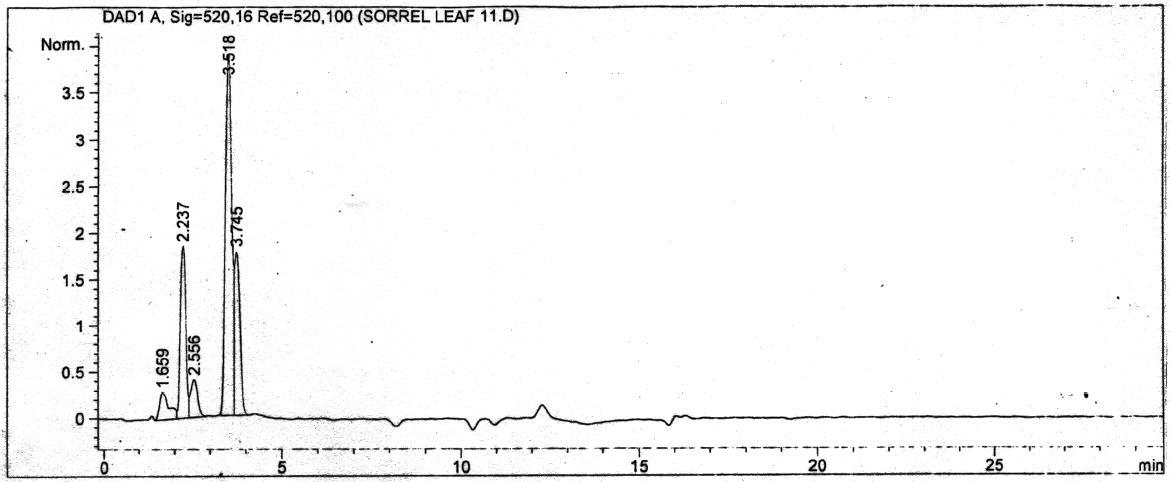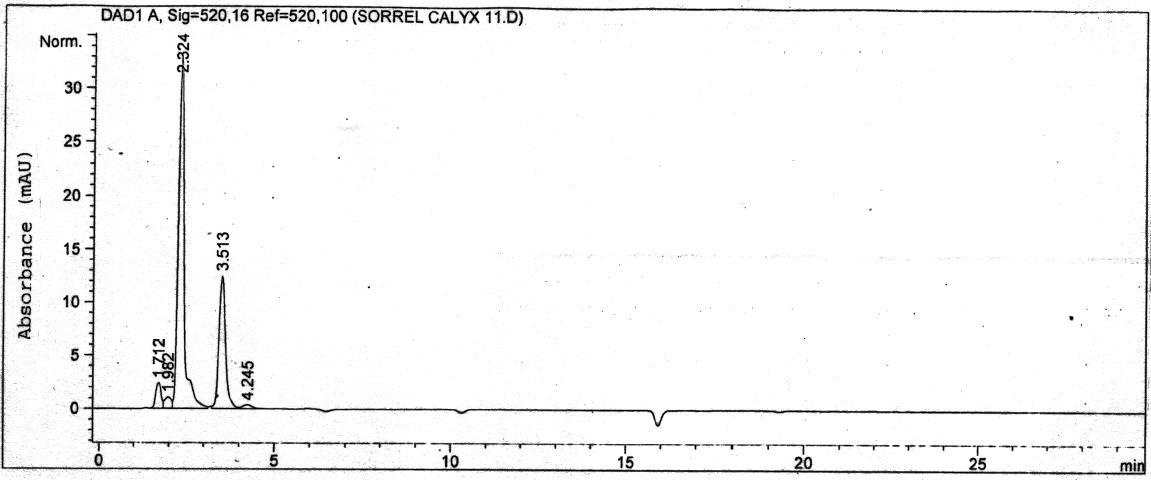ISSN 2348-313X (Print)
International Journal of Life Sciences Research ISSN 2348-3148 (online)
Vol. 9, Issue 1, pp: (67-70), Month: January - March 2021, Available at: www.researchpublish.com

ISSN 2348-313X (Print)
International Journal of Life Sciences Research ISSN 2348-3148 (online)
Vol. 9, Issue 1, pp: (67-70), Month: January - March 2021, Available at: www.researchpublish.com
1Department of Biology and Chemistry, Northern Caribbean University, Mandeville, Manchester, Jamaica W.I.
Correspondence to: P. A. Gyles, Dean of Graduate Studies Northern Caribbean University, Manchester, Jamaica WI, Tel: 8769637149; E-mail: pgyles@ncu.edu.jm
Abstract: Presence of lead and cadmium in sorrel have been reported in other parts of the world. This study sought to explore presence as applicable to local grown and consumption of traditional red variety as samples were grown in mined bauxite rich soils reported to have these cumulative toxins. Seeds had higher concentrations of cadmium; leaves had higher concentrations of lead. All samples had trace amounts of lead and cadmium. While the heavy metals reported in earlier studies (iron, sodium, potassium, calcium, magnesium, and copper) could enhance human health, the potential toxicological effect of lead and cadmium present in known consumable portions of plant recommend moderate consumptions, modern methods to grow void of these toxins, or possible isolation of nutraceutic compounds to gain maximum health benefits Cyanidin and delphinidin for example were reported to inhibit epidermal growth factor receptor in cancer cells, both of which were reported present in sorrel calyxes. Sorrel calyxes and leaves extracts were reported effective against cancers. The presence of these anthocyanins and their reported effect on cancerous cells underscores the plants nutraceutic potentials, whilst presence of lead and cadmium urge caution.
Keywords: Sorrel, Nutraceutical, Extract, Heavy Metals, Anthocyanins.
Presence of lead and cadmium in sorrel have been reported in other parts of the world1; however, this study sought to explore presence as applicable to local grown and consumption. Sorrel plants used in study were cultivated in the parish of Manchester, Jamaica, mined for bauxite over several years2. The presence of cadmium and lead in sorrel extracts was indicative of bauxite mining zone3, and of such, the potential toxicological effects of these elements were of concern in this known nutraceutical plant. In other studies, ―significant correlations were found between soil and agricultural produce concentrations for cadmium and lead in Jamaica (r2 ≥ 0.5)‖4 , which raised concern on rate and quantity of consumption once grown in bauxite rich soil, or method of growing this nutraceutical plant void of lead and cadmium. Soil test prior to planting may be warranted, or isolation of nutraceutic compounds for maximum health potential.
Per the World Health Organization, (WHO), ―cadmium levels in fruit, meat and vegetables are usually below 10µg/kg‖5 , or 0.01ppm. The main consumable portions the calyx reported an average of 5.16µg/L or 0.00516ppm in this study. There is no identified safe blood lead level; however, the Centers for Disease Control and Prevention (CDC) recommends that doctors begin monitoring children who have a blood lead level measured as 5 micrograms per deciliter (µg/dL) or
ISSN 2348-313X (Print)
International Journal of Life Sciences Research ISSN 2348-3148 (online)
Vol. 9, Issue 1, pp: (67-70), Month: January - March 2021, Available at: www.researchpublish.com
0.05ppm, concern levels for adults too per the Agency for Toxic Substances and Disease Registry At this level it is recommended parents, doctors, public health officials, and communities -take steps to reduce the child's future exposure to lead6,7-8 The average reported in main consumable portion in this study, calyx had 5.09µg/L or 0.00509ppm. While the study indicated trace amounts of cadmium and lead in main consumable portions, the net benefit of consumption of sorrel grown in bauxite rich soil remain of concern as heavy metals such as cadmium are reported to be human carcinogens9 , while at the same time, sorrel have been reported effective against cancer(s) in local studies here at Northern Caribbean University and around the world10,11 . Its anti-cancer properties are believed to correlate with its flavonoid content.
Flavonoids represent a large class of secondary plant metabolites, of which anthocyanins are the most conspicuous class, due to the wide range of colors resulting from their synthesis12 Anthocyanins have been reported present in many plants with important functions in plant physiology as well as possible health effects 13. Of the health effects reported, cyanidin and delphinidin were reported to inhibit epidermal growth factor receptor in cancer cells, while malvidin was noted to be less effective14 Hibiscus sabdariffa calyxes have been reported to possess delphinidin-3-O-sambubioside (Dp-samb) and cyanidin-3-O-sambubioside (Cy-samb)15 , which may correlate to its anti-cancer properties observed locally and reported in other studies. The presence of these anthocyanins and their reported effect on cancerous cells underscores the plants nutraceutic potential, whilst presence of lead and cadmium urge caution.
Sorrel plants were grown in the parish of Manchester, Jamaica. Sorrel samples were prepared from modified method(s)16 at Northern Caribbean University. Nitric acid digestion of samples was also done at Northern Caribbean University for heavy metal analysis17 before analysis at Jamaica Bureau of Standards for lead and cadmium. Chromatographic separation of samples via Reverse Phase High Performance Liquid Chromatography were adopted to confirm presence of anthocyanin in samples at Northern Caribbean University18,19 . Analysis done in the year 2011.
Hibiscus sabdariffa (Jamaican sorrel), has nutritional and medicinal benefits to enhance human health and possibly preventing the occurrence and proliferation of certain human plagues like cancers. While the concentrations were relatively low, leaves had higher lead concentrations compared to calyxes, and seeds. Likewise, seeds had higher cadmium concentrations compared to leaves and calyxes (table 1). The presence of these cumulative toxins while being in trace amounts call for methods to grow this nutraceutical void of lead and cadmium or isolation of nutraceutic compounds to maximize health potentials
Calyxes and leaves provided five retention times each, with three distinct peaks in calyxes and five in leaves. Concentrations were lower in leaves based on absorbance (Figure 1,2). Seeds had no chromatographic response. The presence of anthocyanins in sorrel calyxes and leaves based on methods adopted correlates to anticancer properties as observed locally and reported in many studies and may play a part as anti-inflammatory and as chemo-preventative agents since anthocyanins such as cyanidin and delphinidin were reported to inhibit epidermal growth factor receptor in cancer cells. The seeds did not show any compounds that were of benefit apart from those that reported earlier20. These results showed that sorrel calyxes and leaves possess compounds that are important in addressing various health problems. This study shows that sorrel calyxes, seeds, and leaves have potential health benefits that may help in the prevention and treatment of diseases and that mitigation might be necessary to maximize heath potential.
[1] EmeseSipter, EnikőRózsa, KatalinGruiz, ErzsébetTátrai, VeronikaMorvaia (2008) Site-specific risk assessment in contaminated vegetable gardens. ELSEVIER, Volume 71, Issue 7, April 2008, Pages 1301-1307. https://doi.org/ 10.1016/j.chemosphere.2007.11.039
[2] THE JOURNAL OF THE GEOLOGICAL SOCIETY OF JAMAICA BAUXITE /ALUMINA SYMPOSIUM 1971 https://library.wur.nl/isric/fulltext/ISRIC_22704.pdf#page=12
[3] Evens K. (2016) The History, Challenges, and New Developments in the Management and Use of Bauxite Residue. © The Minerals, Metals & Materials Society (TMS) 2016. J. Sustain. Metall. (2016) 2:316–331 DOI 10.1007/ s40831-016-0060-x.
ISSN 2348-313X (Print) International Journal of Life Sciences Research ISSN 2348-3148 (online) Vol. 9, Issue 1, pp: (67-70), Month: January - March 2021, Available at: www.researchpublish.com
[4] Wright, V., Jones, S. & Omoruyi, F.O. Effect of Bauxite Mineralized Soil on Residual Metal Levels in Some Post Harvest Food Crops in Jamaica. Bull Environ Contam Toxicol 89, 824–830 (2012). https://doi.org/10.1007/s00128012-0763-z
[5] World Health Organization (2011) Cadmium in Drinking-water https://www.who.int/water_sanitation_health/ dwq/chemicals/cadmium.pdf
[6] https://www.fda.gov/food/metals-and-your-food/lead-food-foodwares-and-dietary-supplements
[7] https://www.cdc.gov/nceh/lead/prevention/blood-lead-levels.htm?CDC_AA_refVal=https%3A%2F%2Fwww.cdc. gov%2Fnceh%2Flead%2Facclpp%2Fblood_lead_levels.htm
[8] Agency for Toxic Substances and Disease Registry (2017) Lead Toxicity. https://www.atsdr.cdc.gov/csem/ csem.asp?csem=34&po=8
[9] Goyer, R.A., Liu, J. & Waalkes, M.P. Cadmium and cancer of prostate and testis. Biometals 17, 555–558 (2004). https://doi.org/10.1023/B:BIOM.0000045738.59708.20
[10] Rajitha Sunkara, Louis Shackelford, Lloyd Walker, Martha Verghese (2015) Inhibition of Chemically-Induced Colon Cancer by Dietary Treatment of Hibiscus sabdariffa L. Dried Calyx in Rats. Food and Nutrition Sciences Vol.06 No.12(2015), Article ID:59994,9 pages 10.4236/fns.2015.612123 https://www.scirp.org/html/13-2701658_ 59994.htm
[11] Chun-Tang Chiu , Jing-Hsien Chen , Fen-Pi Chou, and Hui-Hsuan Lin (2015) Hibiscus sabdariffa Leaf Extract Inhibits Human Prostate Cancer Cell Invasion via Down-Regulation of Akt/NF- -9 Pathway. Nutrients 2015, 7, 5065-5087; doi:10.3390/nu7075065.
[12] Holton T. A. and Cornish E.C. (1995) Genetics and Biochemistry of Anthocyanin Biosynthesis. The Plant Cell, Vol. 7, 1071-1083, July 1995 © 1995 American Society of Plant Physiologists. https://www.ncbi.nlm.nih.gov/pmc/ articles/PMC160913/pdf/071071.pdf
[13] XIANLI WU, GARY R. BEECHER, § JOANNE M. HOLDEN, # DAVID B. HAYTOWITZ, # SUSAN E. GEBHARDT, # AND RONALD L. PRIOR*,† (2006) Concentrations of Anthocyanins in Common Foods in the United States and Estimation of Normal Consumption. J. Agric. Food Chem. 2006, 54, 4069−4075 https://www.ars. usda.gov/ARSUserFiles/80400525/Articles/JAFC54_4069-4075.pdf
[14] Sterling M. 2001 . Anthocyanins. © 1995 2011 The Chiropractic Resource Organization. Article accessed from http://www.chiro.org/nutrition/FULL/Anthocyanins.shtml
[15] Claudia Grajeda-Iglesias, Maria C. Figueroa-Espinoza, Nathalie Barouh, Bruno Baréa, Ana Fernandes, Victor de Freitas, and Erika Salas (2016) Isolation and Characterization of Anthocyanins from Hibiscus sabdariffa Flowers. J. Nat. Prod. 2016, 79, 7, 1709–1718 Publication Date:June 17, 2016 https://doi.org/10.1021/acs.jnatprod.5b00958
Copyright © 2016 The American Chemical Society and American Society of Pharmacognosy https://pubs.acs.org/ doi/10.1021/acs.jnatprod.5b00958
[16] Aberoumand A . 2010. Comparison of Proximate and Mineral Composition Between Aparagus oficinalis and Momordica dioica: Iranian and Indian Vegetables. ISSN 2079-2115, Iranica Journal of Energy and Environment 1(3): 196-199.
[17] USEPA, 1996. Acid Digestion of Digestion of Sediments, Sludges, and Soils. Method 3050B. 3-4. Article accessed from http://www.epa.gov/osw/hazard/testmethods/sw846/pdfs/3050b.pdf
[18] Durst W. R. Wrolstad W. R., N.d. Seperation and Characterization of Anthocyanins by HPLC. Current Protocols in Food Analytical Chemistry Unit F1.3
[19] Rodriguez-Saona L., Wrolstad W. R 2001. Extraction, Isolation, and Purification of Anthocyanins. Current Protocol in Food Analytical Chemistry Unit F1.1.
[20] D. A. Chambers, P.A. Gyles, A. Miller (2020) Nutritional Analysis of Jamaica’s Hibiscus sabdariffa (Sorrel Calyxes, Seeds, And Leaves). International Journal of Life Sciences Research Vol. 8, Issue 4, pp: (51-54), Month: October - December 2020. ISSN 2348-313X (Print), ISSN 2348-3148 (online), Available at: www.researchpublish. com
ISSN 2348-313X (Print)
International Journal of Life Sciences Research ISSN 2348-3148 (online) Vol. 9, Issue 1, pp: (67-70), Month: January - March 2021, Available at: www.researchpublish.com
Table 1: Heavy Metal Analysis of Hibiscus Sabdariffa var. sabdariffa Calyxes, Seeds, and Leaves looking at Lead and Cadmium.
Average Reported
Sorrel Samples Volume (µL) Lead (µg/L) Cadmium (µg/L)
Calyxes 100 5.09 5.16 5.09±1.846 5.16±0.368 Seeds 100 3.34 15.68 3.34±0.226 15.68±0.127 Leaves 100 16.41 14.07 16.170±7.170 14.07±5.586
Standard Plot Correlation (R2 ): 0.9999 0.9992
Figure 1: HPLC chromatograms of Hibiscus sabdariffa (Jamaican sorrel) Calyx samples

Figure 2: HPLC chromatograms of Hibiscus sabdariffa (Jamaican sorrel) Leaf samples
